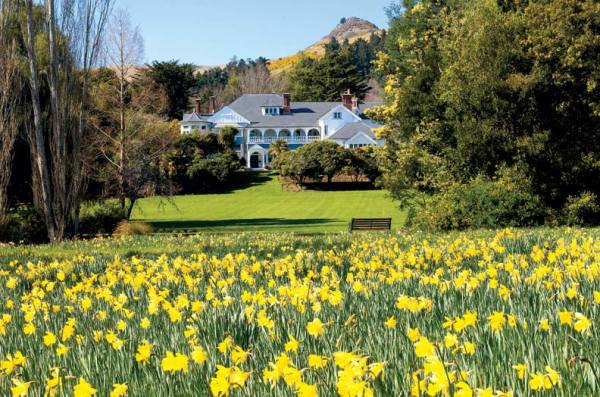
Owners Hall Cannon and Miles Refo revived Sir Heaton Rhodes’ “Daffodil Day” tradition of inviting the public to view the lodge and grounds during peak blooming season.
Built in 1895, the lodge is often cited the finest example of Queen Anne architecture in New Zealand, where imported Victorian details often coalesced into an amalgam of Eastlake, Gothic, and classical styles. Otahuna originally served as the home of Sir Heaton Rhodes, a well-respected politician who lived there until his death at age 95 in 1956. The lodge changed hands several times over the next five decades, serving as everything from a seminary to a commune, before Americans Hall Cannon and Miles Refo bought it in 2006 with the vision of turning it into a luxury retreat.
“In such a young country, it’s very rare to have anything with this history associated with it,” Cannon observes. “That, plus the chance to grow all of our own food on-site, made it the perfect proposition.”
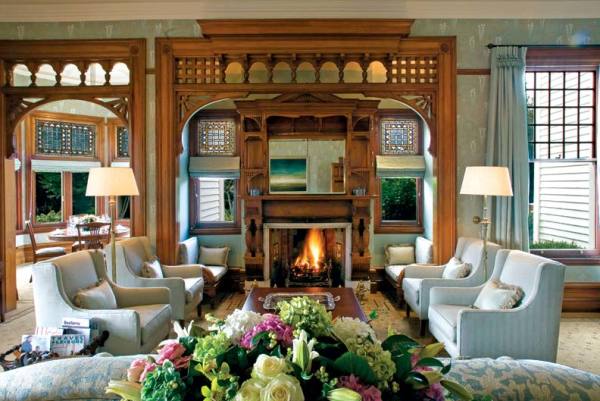
The Eastlake-style inglenook and stained glass in the drawing room are original to the house.
Although the lodge had undergone a meticulous restoration in the 1970s by a couple who used it as their private home, by the time Cannon, Refo, and interior designer Stephen Cashmore came on the scene, the house had become, in Cannon’s words, “soulless and cold.” Most of the original wallpaper had been removed (except for the gold-leaf-patterned pressed paper in the dining room, which is protected by New Zealand’s Historic Places Trust), and the walls had all been painted white. Although much of the ornate woodwork throughout the house remained intact and unpainted, the whitewashed rooms weren’t doing it justice.
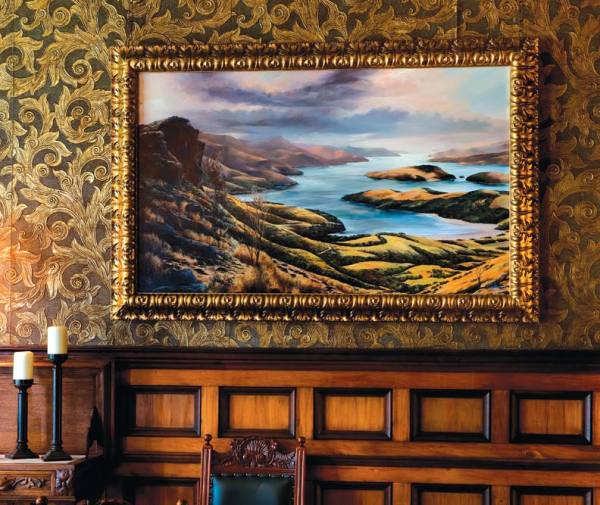
The only original wallpaper remaining in the house, the dining room’s gold-leaf paper is specially protected by New Zealand’s Historic Places Trust.
“Dressing a formal house like this without wallpaper is like going out in the winter without an overcoat on,” says Cashmore. He sought to return color and texture to the house, but did so in a way that reflects its traditional use. In the drawing room, for instance, the walls sport a light blue wisteria-patterned paper that highlights the room’s centerpiece: an Eastlake-style inglenook. “The drawing room would have been the domain of the lady of the house,” Cashmore explains, “so the colors were designed to reflect the traditional colors used in drawing rooms.”
Although the team used original photos of the house as a reference for the restoration, Cannon and Refo wanted to evoke the home’s past rather than produce a slavish copy. “We wanted Otahuna to stand as an example of how history can be interpreted in the present day,” Cannon says. While old photos showed rooms crowded with Sheraton furniture and hunting trophies, for example, today that opulence is evoked through wool- and leather-clad furniture and local artwork.
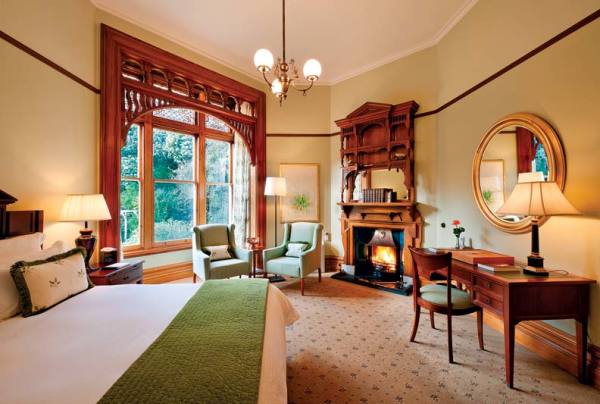
The first-floor Botanical Suite, located in the former morning room, features woodwork similar to that in the drawing room.
The dining-room sideboard was the only original piece of furniture left in the house, so Cashmore designed many of the replacements (including headboards, bathroom vanities, and a sideboard for the drawing room) himself, taking cues from the era of the house. He scoured antique shops across the country to find lighting fixtures. “I first saw the brass lighting fixtures in the reception hall in a shop in Auckland 20 years ago,” he says. “They were still there when I went to pick out lighting fixtures for Otahuna.”
In addition to the interior restoration, the surrounding 20 acres of gardens also were revived. When the house was first built for Sir Heaton, the grounds were virtually bare, so he had a series of gardens installed around the house—including a frog pond, a formal knot garden, and a field of daffodils—most of which were completely overgrown by the time Cannon and Refo took over the house. Using aerial photos of the grounds, head gardener Steve Marcham brought them back to their original appearance. As they were in Sir Heaton’s day, the grounds are used to grow fruit, vegetables, and herbs, and raise sheep, chickens, pigs, and occasionally cattle, all of which figure prominently on the lodge’s menu.
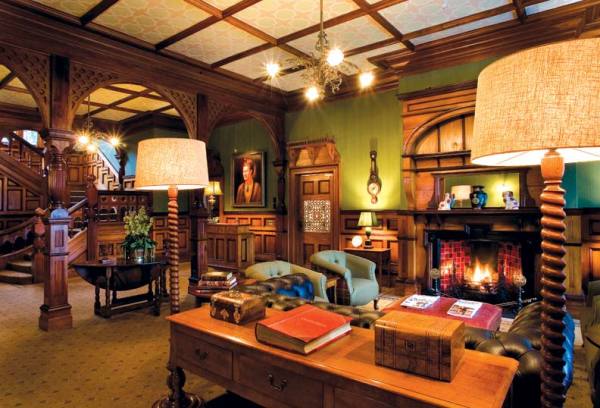
The lobby’s wood paneling was cleaned and oiled; the chandeliers came from an Auckland antique shop.
Although the initial restoration of Otahuna Lodge was completed in just four months, recent years have seen the need for more work to repair damage from Christchurch’s series of crippling earthquakes. The September 2010 quake toppled all of the house’s 11 chimneys, sending some crumbling into original tiled fireplaces. Cannon and Refo hired Fletcher Construction to rebuild the uniquely patterned chimneys; to prevent damage from future earthquakes, they designed the chimneys with concrete block centers and a brick veneer that replicates the originals. The broken tiles were replaced with matching ones that Cashmore tracked down at a Christchurch demolition yard.
At the same time, Cannon and Refo had seismic reinforcement installed in the attic. Thanks to the upgrades, subsequent earthquakes in February and December 2011 resulted in only cosmetic damage. “Otahuna is the only heritage residence in New Zealand that operates at 100-percent seismic code,” says Cannon. “We want it to stand for the next 117 years.”







